I have collected a few pics from the years after the bombing of Pearl Harbor, Dec 7, 1941. I will present year by year, through 1945.
Might take me a few days, but we are on our yearly trip to the beach, & the weather is crappy, so I have some time on my hands sitting here inside the condo on the 8th floor, over looking the Gulf Of Mexico.

Here are some from the days/months after Pearl Harbor. All photos are from the U.S.F.G. unless otherwise noted.
Here Ya go. No particular order.
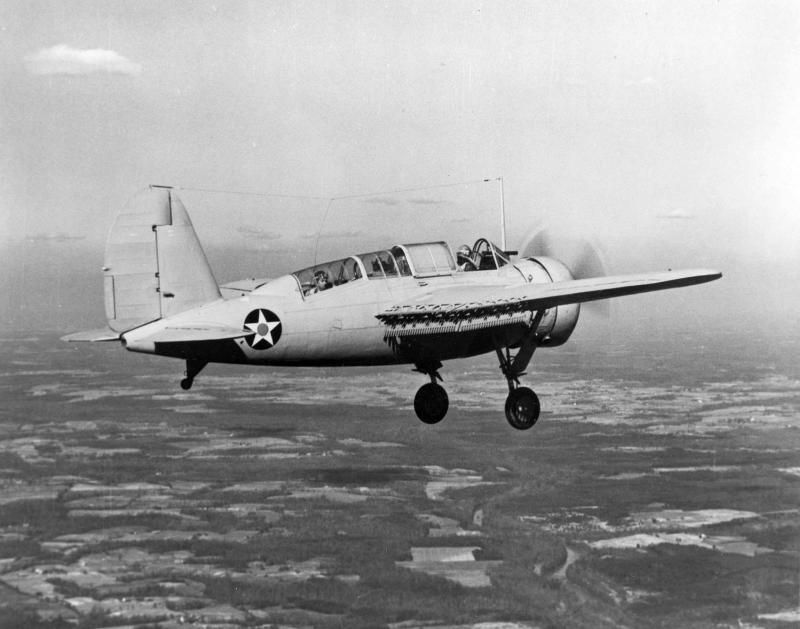
A U.S. Navy Naval Aircraft Factory SBN-1 of torpedo squadron VT-8 in flight, 1941/42. The aircraft served as a trainer for pilots and aircrewmen of the squadron, which was decimated during the Battle of Midway in June 1942 while flying Douglas TBD-1 Devastators off USS Hornet (CV-8). -
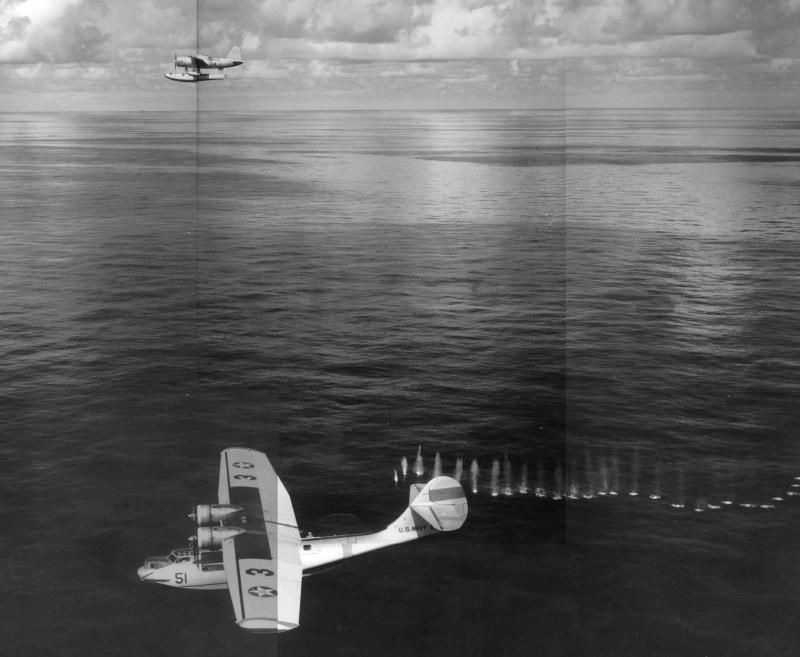
A U.S. Navy Consolidated PBY-2 Catalina at low level over the waters surrounding Pensacola, Florida (USA), during a gunnery training flight. Note the geysers on the water made by a machine gun fired from the blister on the starboard side of the aircraft. The head and shoulders of the gunner are also visible. An Vought OS2U Kingfisher flies off the starboard wing the PBY.
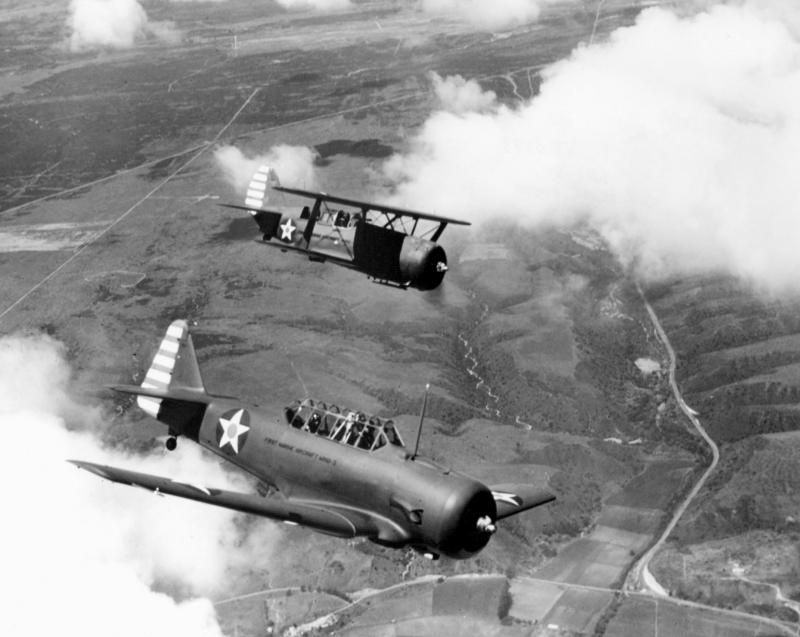
A U.S. Marine Corps North American SNJ-3 Texan and a Curtiss SBC-4 Helldiver ssigned to the First Marine Air Wing in flight in early 1942. -
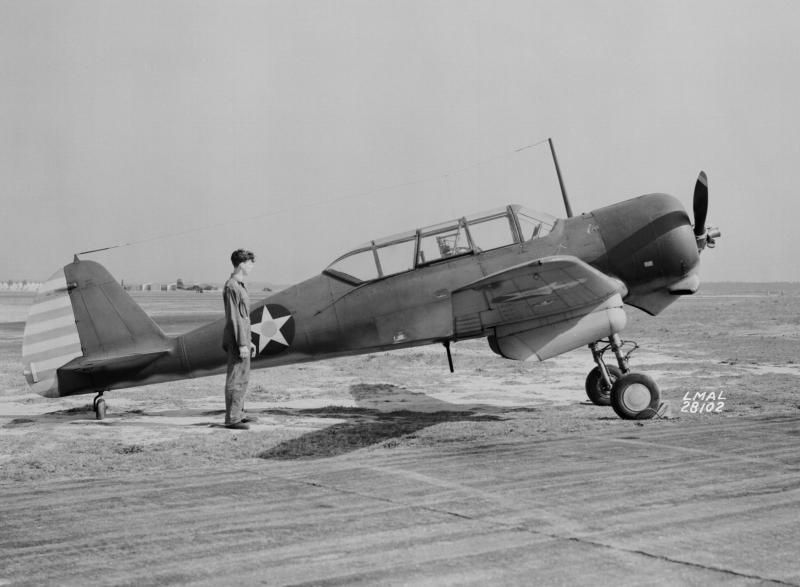
A U.S. Navy Curtiss SNC-1 Falcon trainer (BuNo 6293) at the NACA Langley Research Center, Virginia (USA), on 30 April 1942. -
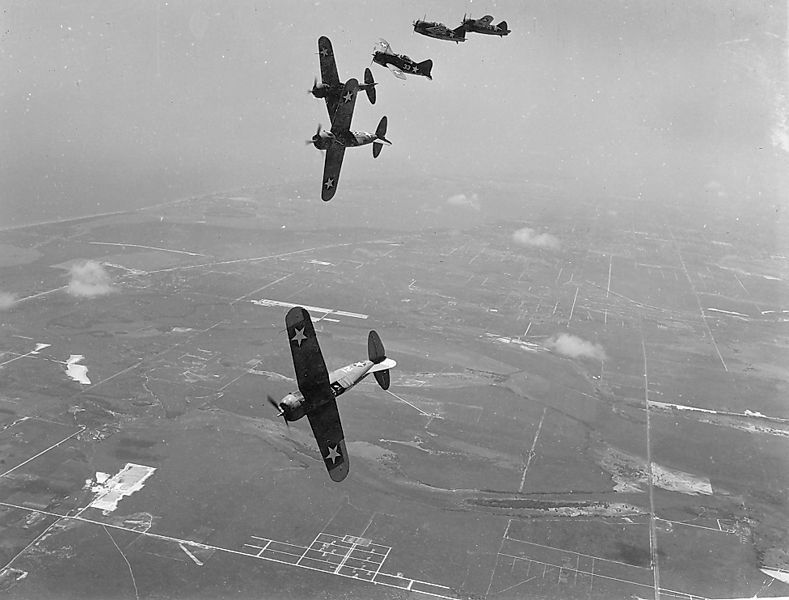
U.S. Navy Brewster F2A-3 Buffalo fighters pictured during a training flight from Naval Air Station (NAS) Miami, Florida (USA), 1942. -
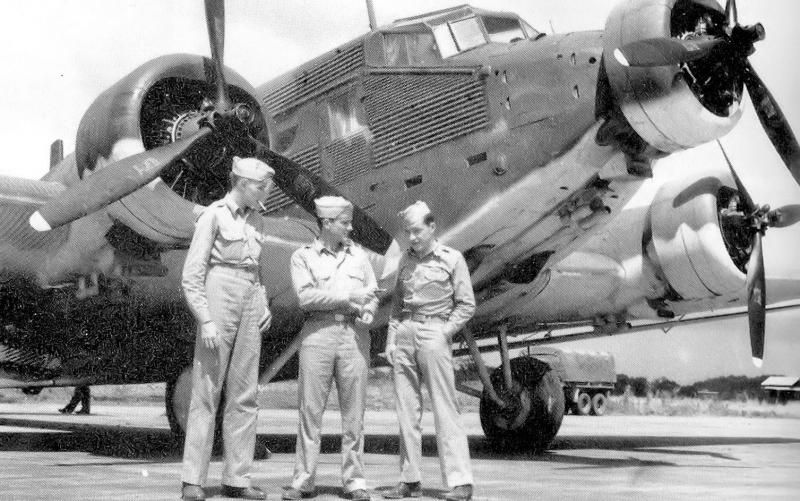
A former German Junkers Ju 52/3m at Howard Field, Panama Canal Zone, in late 1942, in service with the USAAF 20th Transportation Squadron, Sixth Air Force. The aircraft was designated as a C-79 and given the serial 42-52883 while in USAAF service. This Ju 52/3m ge (c/n J5283) had originally been D-AENF. On 1 April 1937, it was transferred to Lufthansa Südamerika for Andes service and named "Aconcagua". It was again transferred to the Brazilian airline Sindicato Condor as PP-CBA on 11 September 1939 and then to Lufthansa Sucursal Peru as OA-HHD on 29 November 1940. Syndicato Condor then leased it to Sociedad Ecuatoriana de Transportes Aereos (SEDTA) on 25 April 1941, where it was registered as HC-SAD. It was confiscated by Peruvian government on 5 September 1941 an acquired by the USAAF as war prize on 13 May 1942. The aircraft was refitted with Pratt & Whitney R-1690 engines with modified cowlings and 3-bladed propellers. The air-brakes were replaced with hydraulic brakes, a tail wheel was installed instead of the original skid. All instruments and the radio were replaced with U.S. equipment. In December 1943, it was turned over to the U.S. Public Roads Administration in Costa Rica in as TI-60. Further records show that the aircraft was condemned on 20 December 1943 or 7 December 1944. -
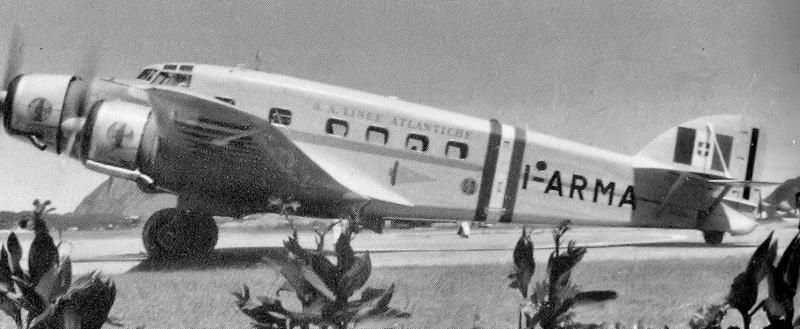
Italian Savoia-Marchetti SM.81 tri-motor airliner in USAAF service - Howard Field, Panama, 1942. This aircraft was acquired by the USAAF from the Italian Latin American Airline LATI which was seized in Chile by local government officials and provided to the squadron due to the severe shortage of USAAF transports in Central America. Although flown to Howard Field, the aircraft was not used for any operational missions.
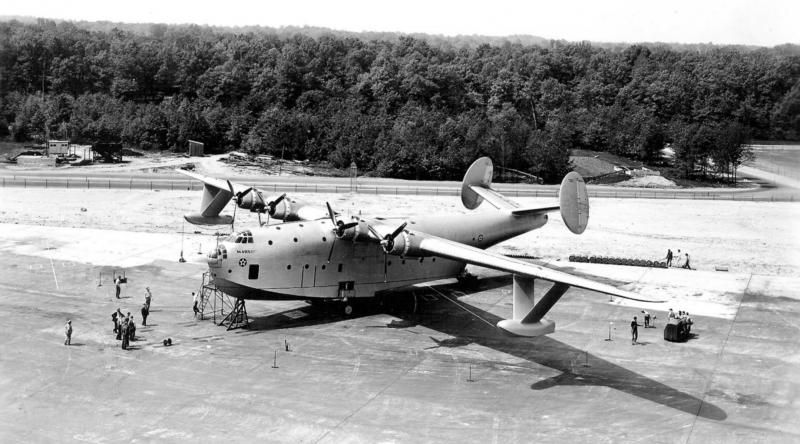
The U.S. Navy Martin XPBM2-1 Mars (BuNo 1520) on the ground on 13 May 1942. This aircraft was later modified as a XPB2M-1R transport. Named "Old Lady", it was beached at Alameda, California (USA) in mid 1945 and subsequently scrapped. The production Martin JRM Mars was the largest Allied flying boat to enter production. Named the "Marianas Mars", "Philippine Mars", "Marshall Mars", "Caroline Mars", and a second "Hawaii Mars", the five production Mars aircraft entered service ferrying cargo to Hawaii and the Pacific Islands.
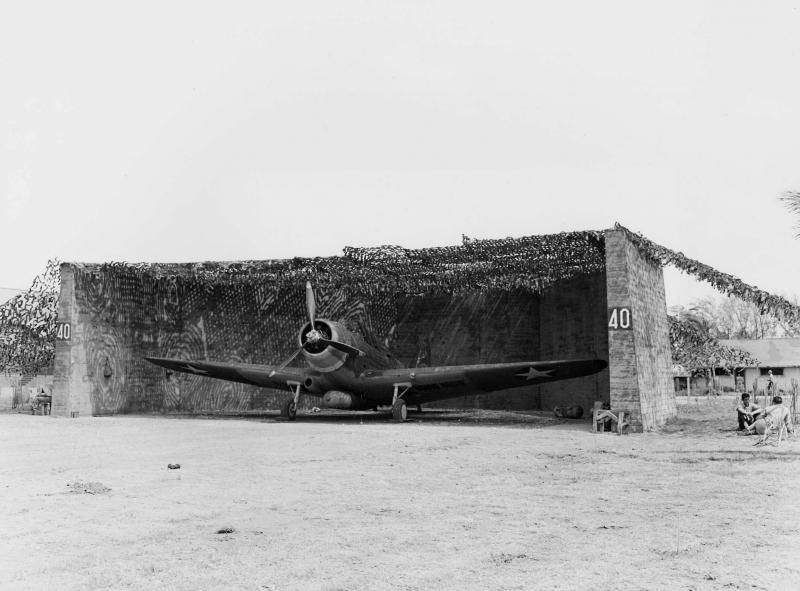
A U.S. Navy Douglas TBD-1 Devastator of Torpedo Squadron Three (VT-3) in a camoflauged revetment at Naval Air Station Kaneohe Bay, Territory of Hawaii, just days before the Battle of Midway. Note the torpedo slung beneath the aircraft's fuselage. The squadron's only combat missions flying Devastators came at the Battle of Midway during June 1942. Launched from the aircraft carrier USS Yorktown (CV-5), the squadron attacked the Japanese carrier fleet on the morning of 4 June. Of the 24 pilots and crewmen who participated in the mission, only three survived. -
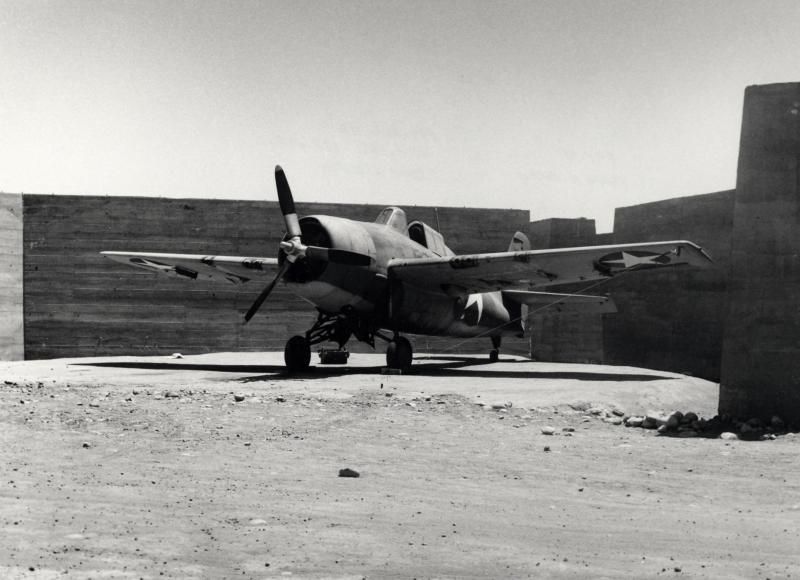
A U.S. Marine Corps Grumman F4F-4 Wildcat of Marine Fighting Squadron VMF-122 in a revetment at Camp Kearney, located on the site of the future Naval Air Station (later MCAS) Miramar, California (USA).
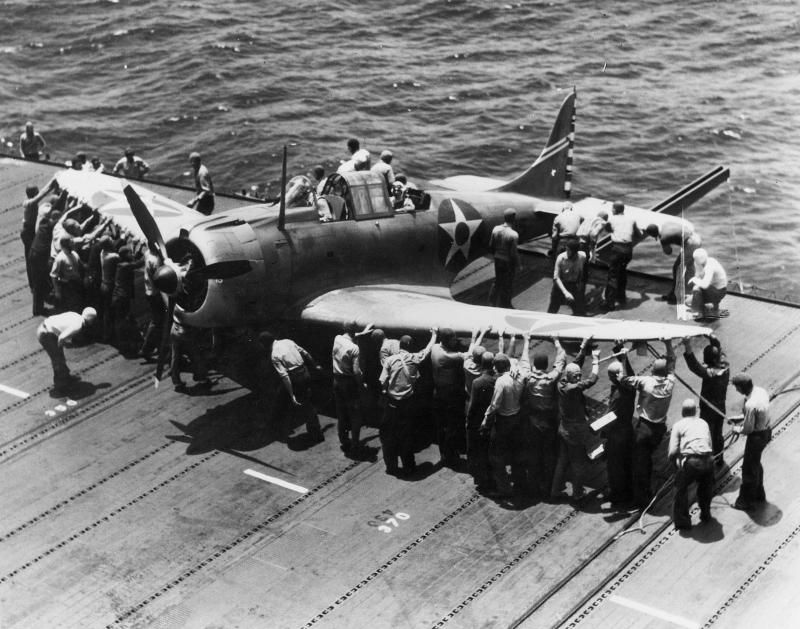
U.S. Navy flight deck personnel maneuver a Douglas SBD-3 Dauntless of bombing squadron VB-6 onto a deck edge wheel mount on the aircraft carrier USS Enterprise (CV-6), 17 April 1942. This allowed for more room on the flight deck. The SBD-3 6-B-15 (BuNo 4542) was flown during the Battle of Midway by Ensign George H. Goldsmith, pilot, and Radioman 1st Class James W. Patterson, Jr. It was damaged during the attack on the Japanese aircraft carrier Kaga on 4 June 1942 and landed on the USS Yorktown (CV-5) as it was low on fuel. It was later lost with the carrier. -
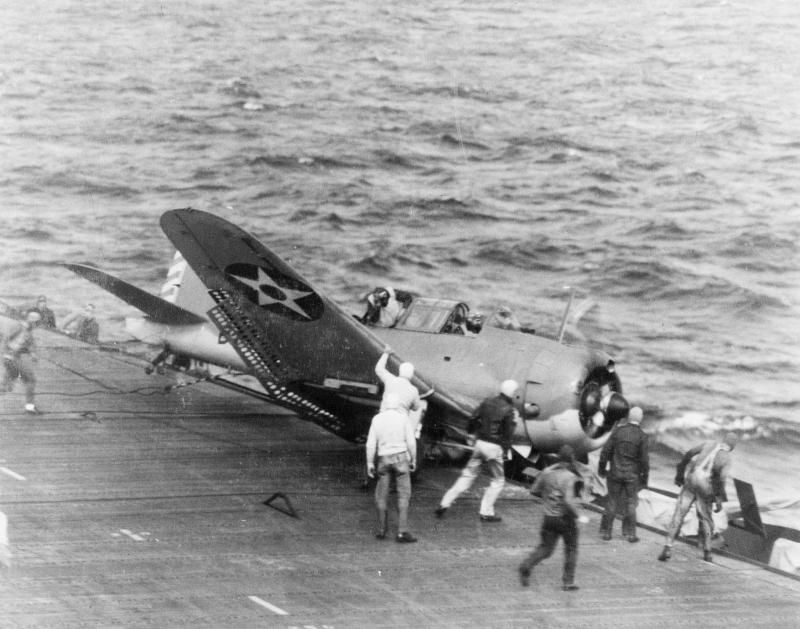
U.S. Navy Douglas SBD-2/3 Dauntless of bombing squadron VB-6 crashes into the catwalk after catching an arrestor wire on the aircraft carrier USS Enterprise (CV-6) during operations in the Pacific, in early 1942.
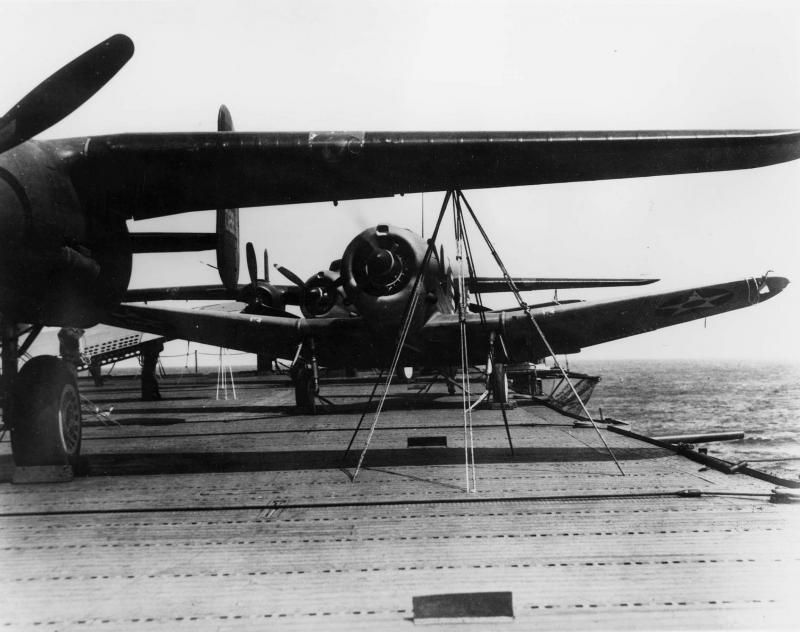
U.S. Navy Douglas SBD-3 Dauntless dive bombers of bombing squadron VB-8 and scouting squadron VS-8 tied down on the flight deck of the aircraft carrier USS Hornet (CV-8) during the carrier's participation in launching the "Doolittle Raiders" against Tokyo, April 1942. Note that parts of the wings and tails of some of the USAAF North American B-25B Mitchell bombers are visible in the photograph.
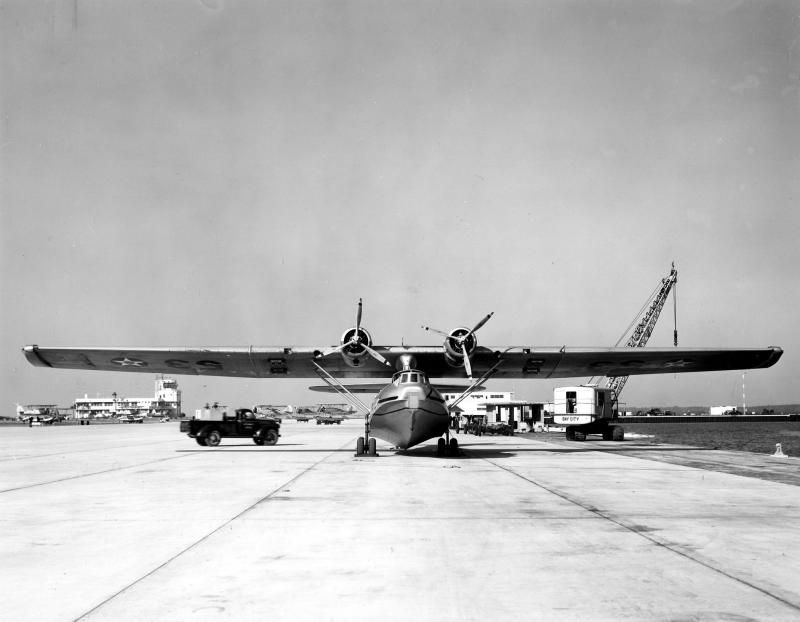
Front view of a Consolidated PBY-2 Catalina on the seaplane ramp at Naval Air Station Jacksonville, Florida (USA). These PBYs were replaced with the PBY-5 in 1943. This picture was taken on 8 January 1942. Naval aircraft Factory N3N-3 trainers are visible in the background.
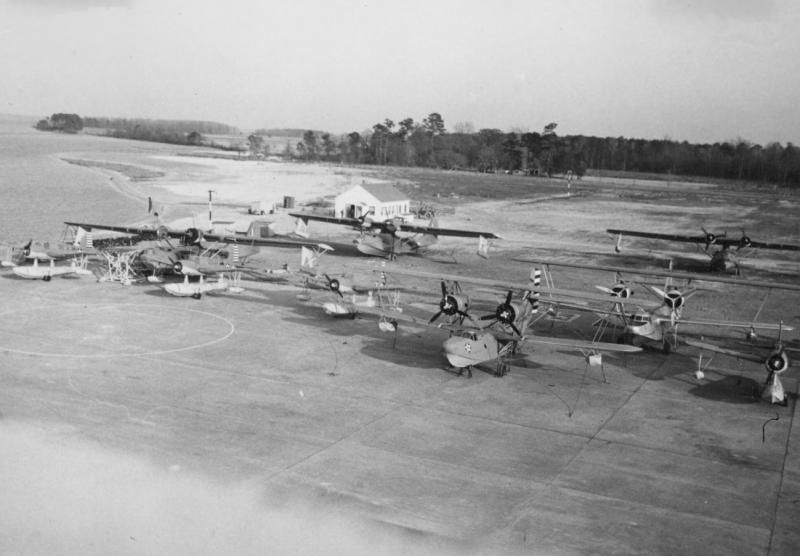
Four Vought OS2U Kingfishers, three Consolidated PBY Catalinas, and two Hall PH flying boats parked at the U.S. Coast Guard Air Station (CGAS) Elizabeth City, North Carolina (USA), 21 March 1942. -
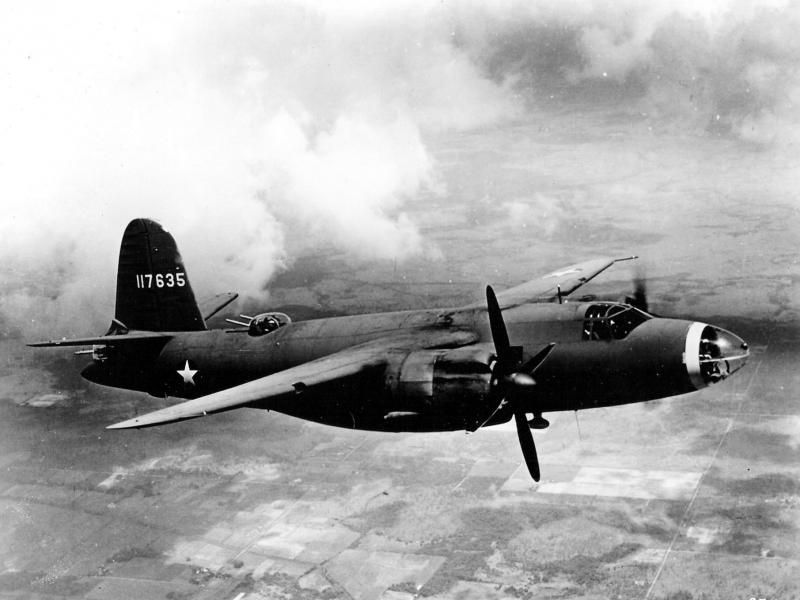
A U.S. Army Air Forces Martin B-26B-MA Marauder (s/n 41-17635) in flight with the starboard propeller feathered. This aircraft crashed at Myrtle Beach, South Carolina (USA), on 4 December 1942 (pilot: Rosser C. Forbes).
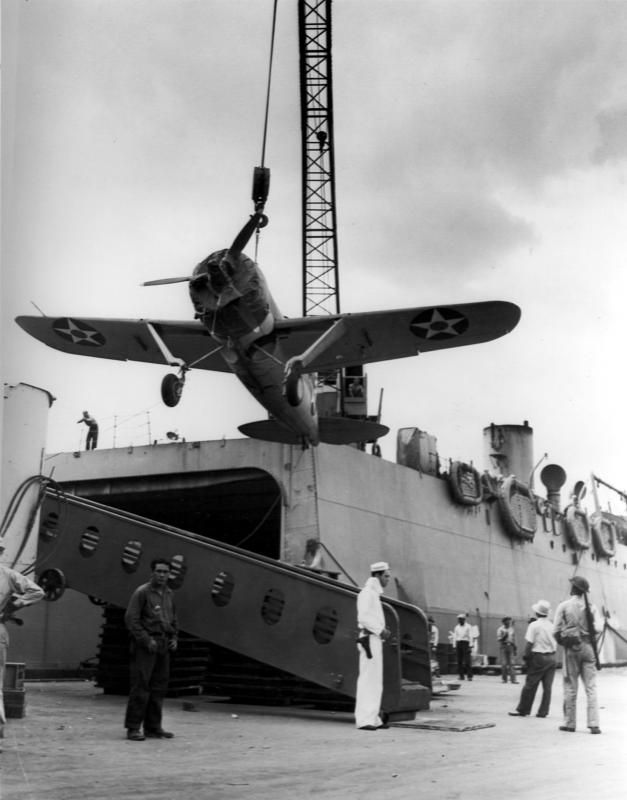
A U.S. Marine Corps Brewster F2A-3 Buffalo from Marine Fighting Squadron VMF-211 is loaded aboard the aviation transport USS Kitty Hawk (APV-1) at Pearl Harbor for shipment to Midway Islands, in May 1942. The F2As had previously been operated by VF-2. After shakedown Kitty Hawk departed New York on 16 December 1941, for Hawaii via the Panama Canal with aircraft to replace the losses in the Japanese attack and arrived Pearl Harbor 8 February 1942. She unloaded her planes at Hickani Field and returned to the U.S. mainland 25 February. Kitty Hawk returned to Pearl Harbor 17 May. Intelligence reports arrived indicating that a Japanese fleet was approaching the Hawaiian Islands. Immediately Kitty Hawk loaded the men, armament, and equipment of the 3d Marine Defense Battalion and planes of Marine Air Groups 21 and 45 and sailed at top speed to reinforce Midway, escorted by Owyn. Kitty Hawk delivered men and aircraft to Midway on 26 May 1942. Escorted by destroyers USS Gwin (DD-433) and USS Sicard (DD-346), Kitty Hawk departed Midway 29 May and arrived at Honolulu on 1 June 1942.
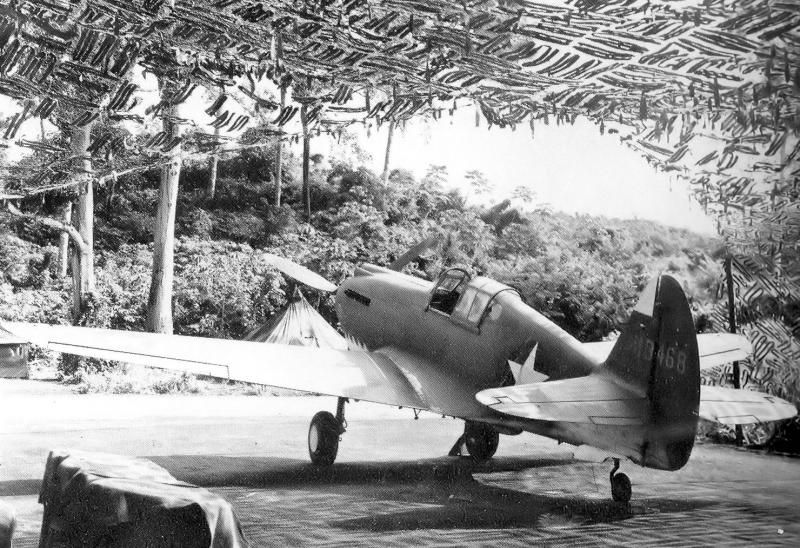
1st Pursuit Squadron Curtiss P-40C 41-13468 (Squadron #91) at La Joya Field #1 Panama, December 1942.
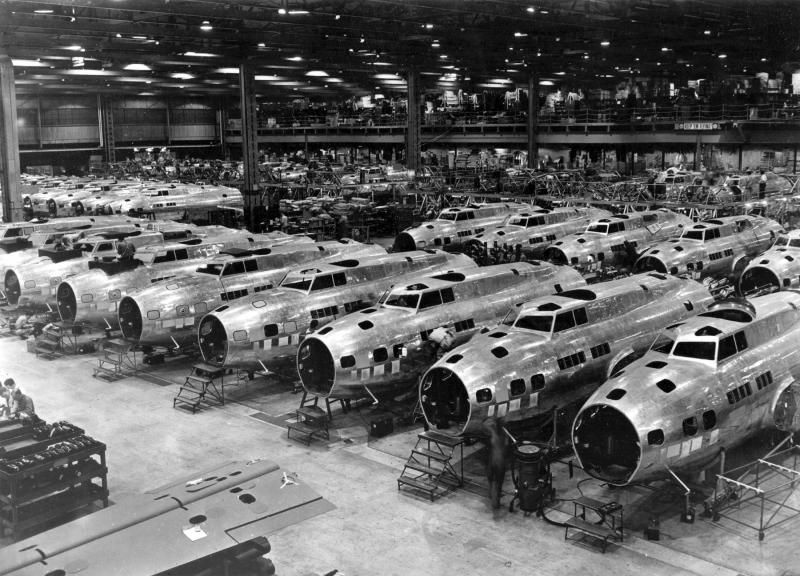
oeing B-17Es under construction. This is the first released wartime production photograph of Flying Fortress heavy bombers at one of the Boeing plants, at Seattle, Wash. Boeing exceeded its accelerated delivery schedules by 70 percent for the month of December 1942. -
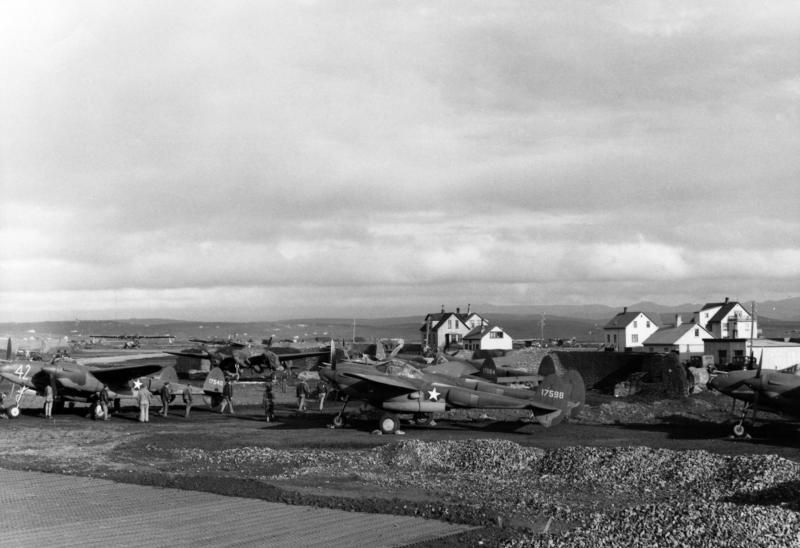
U.S. Army Air Forces Lockheed P-38F-1-LO Lightning fighters (identifiable are s/n: 41-7540, 41-7594, 41-7598) of the 1st Fighter Group during a refueling stop in Iceland on their way to England in the summer of 1942. 41-7540 was flown by Lt. Elza E. Shahan (27th Fighter Squadron) on 14 August 1942. He shot down a Focke-Wulf Fw 200 Condor over the Atlantic, together with 2nd Lieutenant Joseph Shaffer of the 33rd FS Squadron, 8th FG, (flying a Curtiss P-40C). This was the first USAAF victory over a German aircraft in World War II. -
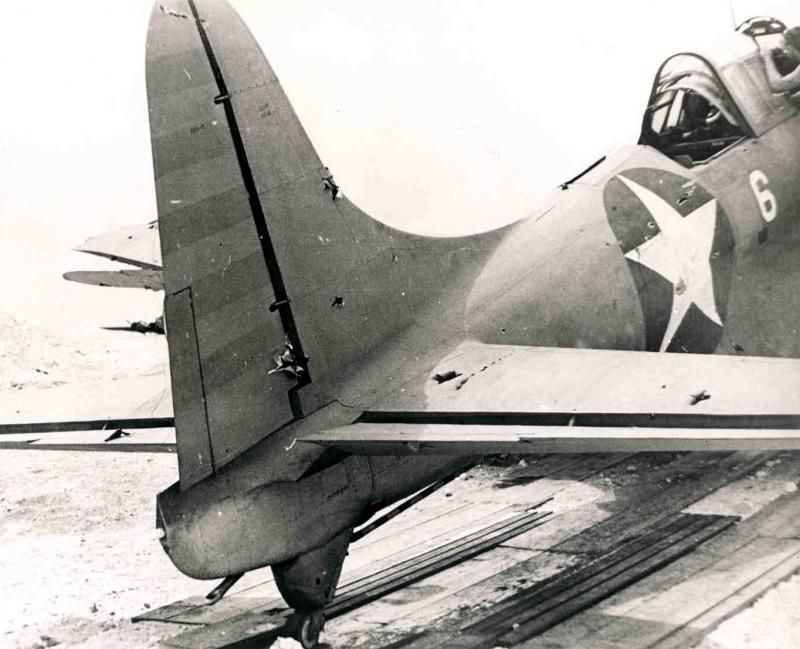
++
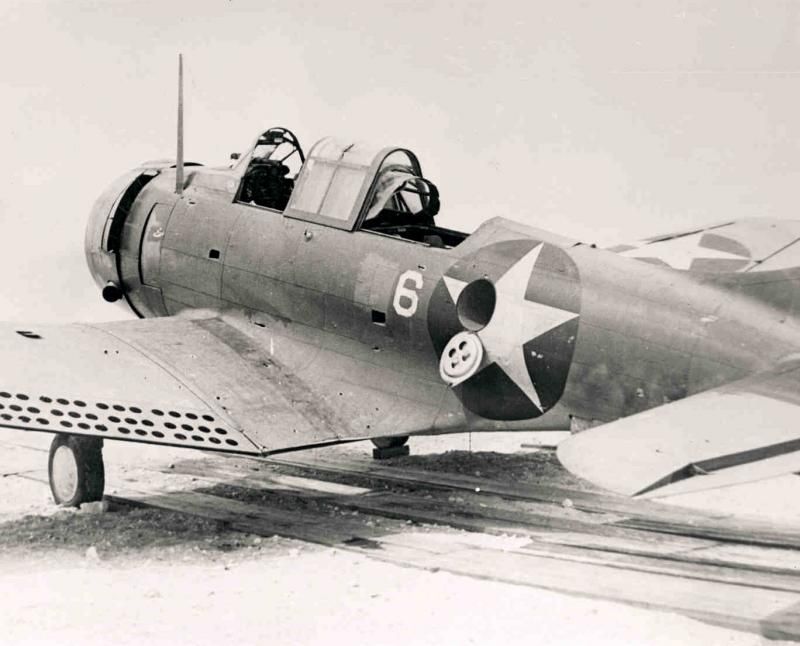
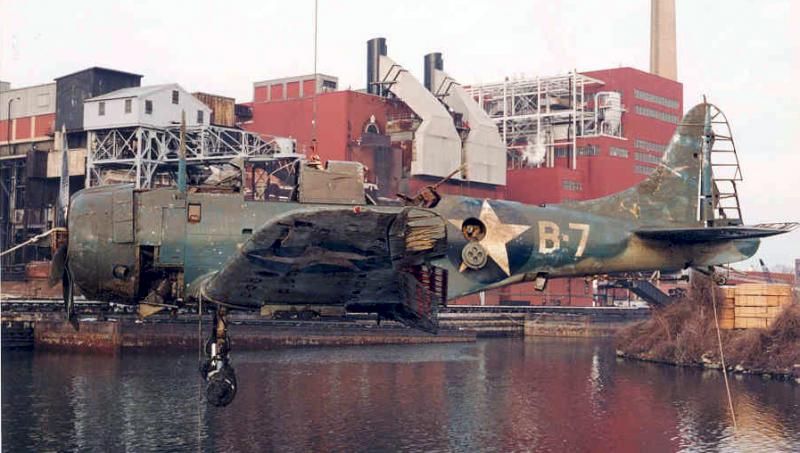
A U.S. Navy Douglas SBD-2 Dauntless after being raised from Lake Michigan in 1994. It is on display at the U.S. National Museum of Naval Aviation at Pensacola, Florida (USA), since 2001. Official description: "Rolling off the Douglas Aircraft Company assembly line in El Segundo, California, in December 1940, SBD-2 Dauntless (BuNo 2106) was delivered to bombing squadron VB-2 at Naval Air Station (NAS) San Diego, California, on the last day of 1940. On 10 March 1942, flown by Lt(jg) Mark T. Whittier with AR2C Forest G. Stanley as his gunner, the aircraft joined 103 other planes from USS Lexington (CV-2) and USS Yorktown (CV-5) in a raid against Japanese shipping at Lae and Salamaua in New Guinea. It was then transferred to Marine scout bombing squadron VMSB-241 on Midway Atoll, arriving there with eighteen other SBD-2s on 26 May 1942, on board the aircraft transport USS Kitty Hawk (APV-1). On the morning of 4 June 1942, with 1st Lt Daniel Iverson as pilot and PF1c Wallace Reid as rear gunner, the aircraft was one of sixteen SBD-2s of VMSB-241 launched to attack Japanese aircraft carriers to the west of Midway. After unsuccessfully attacking the carrier Hiryu, enemy fire holed the plane 219 times. It was one of only eight SBD-2s of VMSB-241 to return from the attack against the Japanese fleet. Returned to the US, it was repaired and eventually assigned to the Carrier Qualification Training Unit (CQTU) at NAS Glenview, Illinois. On the morning of 11 June 1943 Marine 2nd Lt Donald A. Douglas Jr. ditched the aircraft in the waters of Lake Michigan during an errant approach to the training carrier USS Sable (IX-81). Recovered in 1994, the aircraft underwent extensive restoration at the museum before being placed on public display in 2001.
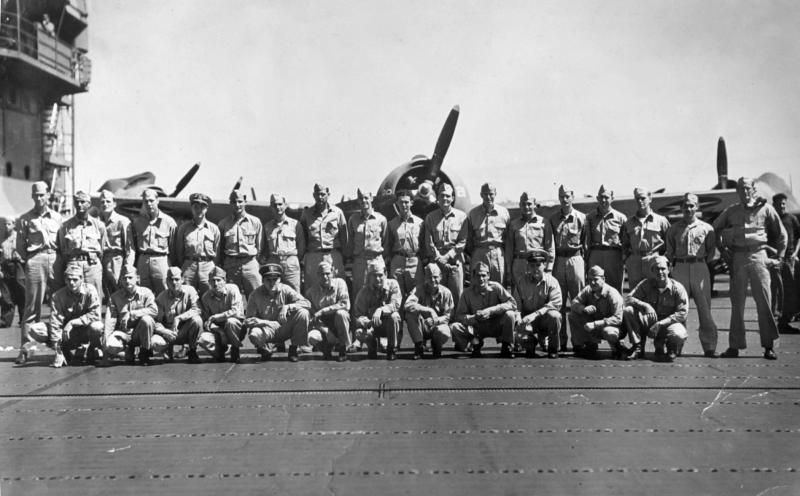
U.S. Navy squadron members of Fighting Squadron VF-3 pose aboard the USS Enterprise (CV-6) in June of 1942 after the Battle of Midway. -
Hope this was ok, just remember, :I Ain't No Jack Cook'!

Robbie






